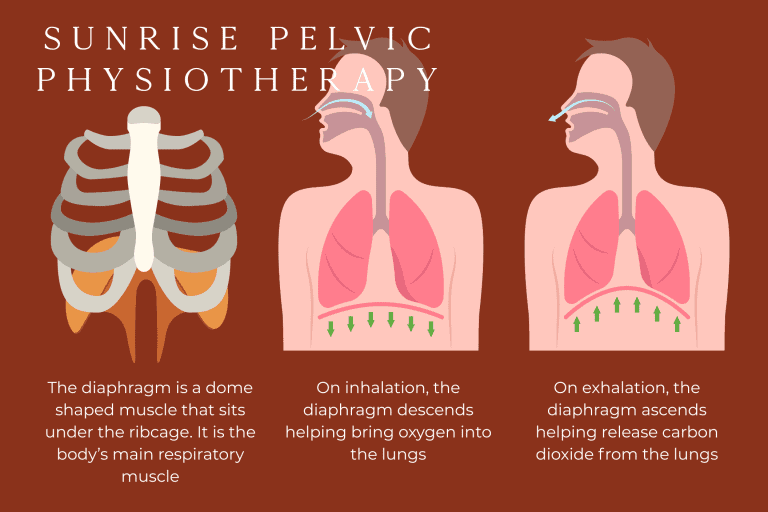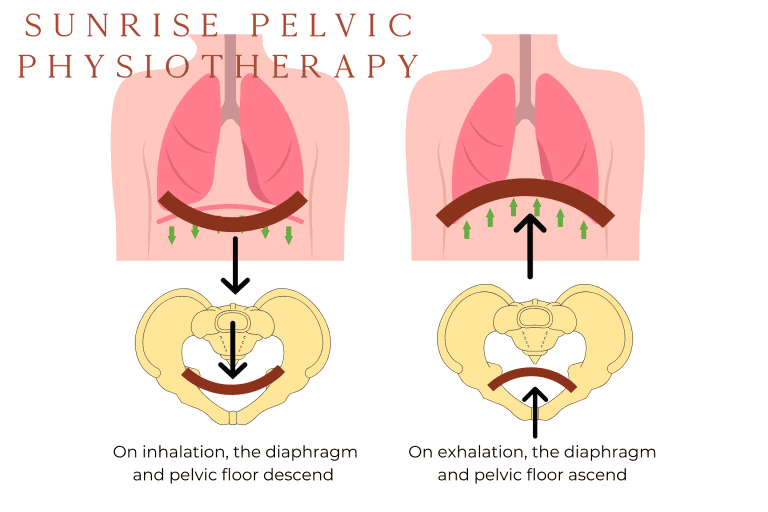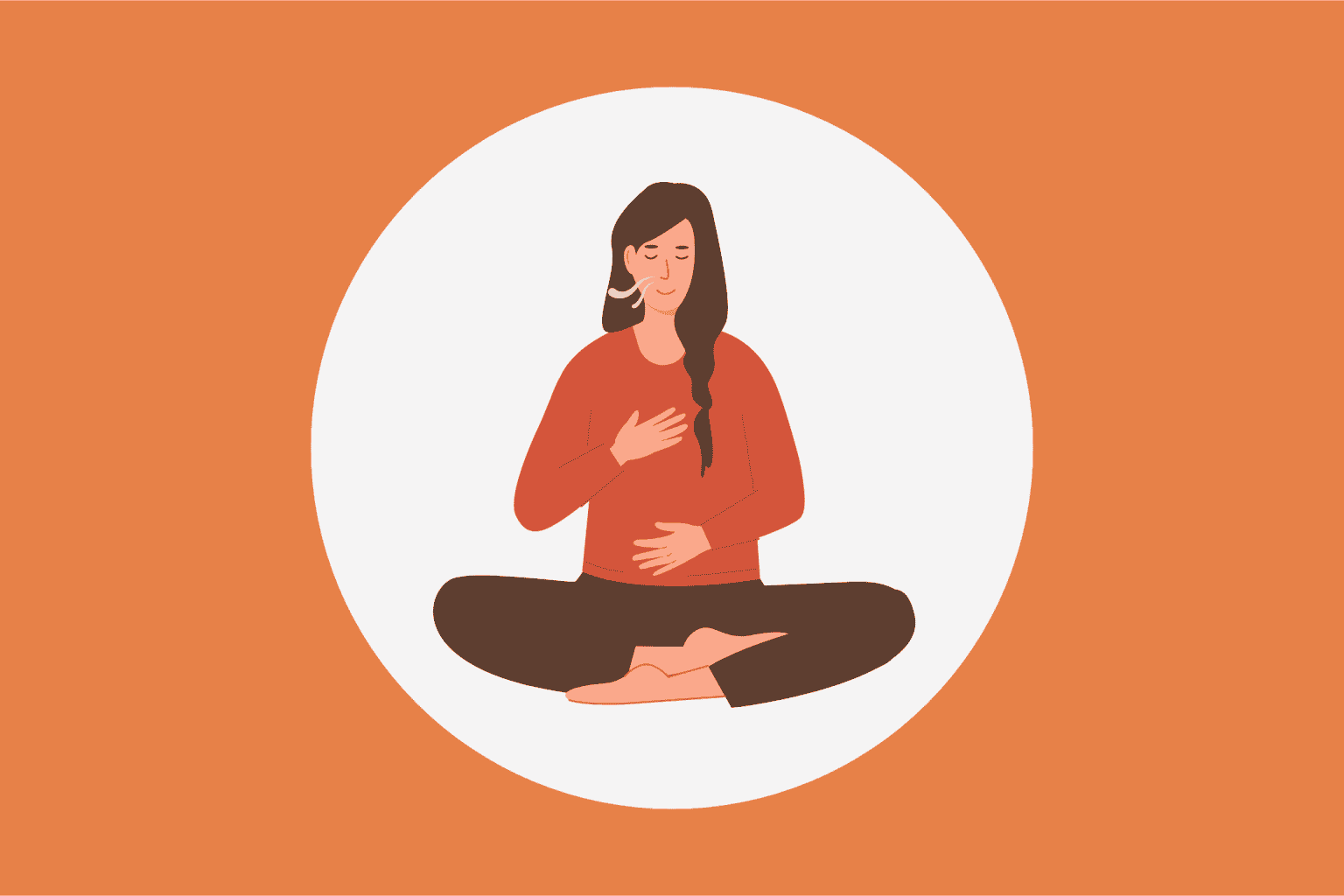We all breathe subconsciously throughout the day but how often do we think about how we breathe? And how does our breathing pattern affect us? How you breathe can have a profound impact on your stress levels, your pain, your overall health and even your pelvic health.
One of the most effective techniques to support pelvic floor function is diaphragmatic breathing – a simple but powerful practice that improves oxygenation, as well as help with activation and relaxation of the pelvic floor muscles.
What is Diaphragmatic Breathing?
Diaphragmatic breathing, often called “belly breathing,” is a technique that focuses on intentionally engaging the diaphragm – our primary respiratory muscle. Unlike shallow chest breathing, which often recruits other accessory neck and upper chest muscles, diaphragmatic breathing uses the full capacity of the lungs and encourages deeper, slower breaths that promote relaxation and optimal muscle engagement.
Benefits of diaphragmatic breathing include:
- Reducing pelvic floor tension: If you experience tightness or discomfort in your pelvic floor diaphragmatic breathing is a simple and easy way to help encourage relaxation and alleviate pain.
- Supporting pelvic floor recovery: After childbirth, surgery, or injury, diaphragmatic breathing can aid in the rehabilitation of the pelvic floor muscles by promoting proper function and relaxation.
- Managing stress: Diaphragmatic breathing is a great tool for managing anxiety and stress, which are often linked to pelvic floor issues such as pelvic pain or incontinence. It also helps our parasympathetic nervous system, which is responsible for the body’s rest and digest response and a calm physical state.
Basic Anatomy: The Diaphragm, Pelvic Floor, and the Nervous System
To understand how diaphragmatic breathing works and how it impacts the pelvic floor, an overview of anatomy is helpful.
- The Diaphragm: The diaphragm is a large, dome-shaped muscle that sits at the base of the rib cage and separates the chest from the abdomen. It is our primary muscle of respiration. On inhalation, the diaphragm flattens and moves downward, making room for the lungs to expand and helping promote blood and oxygen exchange. On exhalation, it rises, helping to expel carbon dioxide (the waste product of breathing) of the lungs.
- The Pelvic Floor: The pelvic floor muscles are a group of muscles located at the bottom of the pelvis, forming a supportive “hammock” that helps support the pelvic organs (bladder, uterus, rectum). These muscles also help control functions of the bladder and bowel, and play a role in sexual function.
- The Nervous System: The autonomic nervous system (ANS) controls involuntary functions in the body, including heart rate, digestion, and respiration. This system is divided into two branches: the sympathetic (fight-or-flight) and parasympathetic (rest-and-digest) systems. The parasympathetic system directly affects the functioning of the pelvic organs in bladder, bowel and sexual function.

Diaphragmatic Breathing and the Pelvic Floor
There is a direct interaction between the movement of the diaphragm and the pelvic floor. If you think of your abdomen as a cannister, the diaphragm is the lid and the pelvic floor is the base. When we breathe, the pressure in this barrel changes and the diaphragm and pelvic floor move together to maintain a balance of internal pressure.
On an inhale, the diaphragm descends to allow the lungs to fill with air. At the same time, the pelvic floor relaxes and lengthens to accommodate the increased pressure inside your abdomen. During exhalation, the diaphragm rises, and the pelvic floor gently contracts and lifts.
This rhythmic relationship between the diaphragm and pelvic floor muscles helps maintain proper muscle tone and promotes relaxation, which is crucial for pelvic health.

How to Practice Diaphragmatic Breathing
Here’s a simple step-by-step guide to help you practice diaphragmatic breathing:
- Find a Comfortable Position: Begin by lying down on your back with your knees bent and feet flat on the floor. You can also practice this sitting or standing once you become familiar with the technique.
- Place Your Hands: Place one hand on your breastbone and the other on your lower abdomen. This will help give you feedback and help monitor the movement of your diaphragm.
- Inhale Slowly: Take a deep breath in through your nose. As you inhale, allow your belly to gently rise and expand outward, engaging the diaphragm. The hand on your chest should stay mostly still, while the hand on the abdomen should rise.
- Exhale Slowly: Gently exhale through pursed lips. As you do, the belly will gently fall, and you may feel your pelvic floor and abdominals gently engage. Try to make your exhale longer than your inhale, which encourages activation of the parasympathetic nervous system to help you further relax.
- Repeat: Practice this breathing technique for 5–10 minutes daily to build awareness, help with overall relaxation and strengthen your connection to the pelvic floor and diaphragm.
Diaphragmatic Breathing and the Nervous System
Breathing is inherently linked to the nervous system. When we take deep, diaphragmatic breaths, the body is signalled to activate the parasympathetic nervous system, which promotes relaxation. This is the “rest-and-digest” state, the opposite of the “fight-or-flight” sympathetic state that is often triggered by stress.
By engaging the diaphragm through diaphragmatic breathing, you activate the vagus nerve, which is the main nerve of the parasympathetic nervous system. This activation helps reduce stress levels, lowers heart rate, and promotes a sense of calm. For people with pelvic floor dysfunction, this calming effect can be incredibly helpful in reducing pelvic floor tension, spasms, and discomfort.
Vagus Nerve Stimulation
An interesting aspect of diaphragmatic breathing is its connection to the vagus nerve, a key component of the parasympathetic nervous system. The vagus nerve is the longest cranial nerve in the body, extending from the brainstem down through the neck and thorax, and branching to various organs, including the heart, lungs, and digestive system. It plays a major role in regulating autonomic functions like heart rate, digestion, and respiratory rate, promoting the body’s relaxation response.
As the vagus nerve encourages relaxation, it counteracts the stress response. This helps reduce feelings of anxiety, tension, and overactivity in the nervous system, which often manifests as pelvic floor tightness and discomfort. It also helps lower the heart rate, creating a calming effect in the body.
Whether you’re managing pelvic floor dysfunction or simply aiming to enhance your overall health, diaphragmatic breathing is a powerful technique to include in your daily routine. If you’re unsure whether you’re doing it correctly, feel free to ask one of our physiotherapists for guidance.





